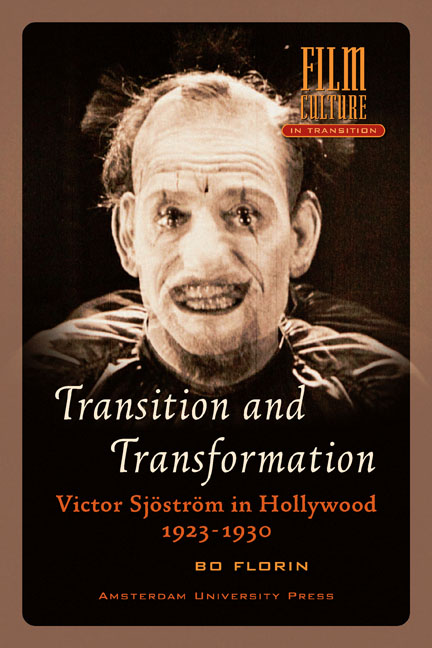Book contents
- Frontmatter
- Contents
- Acknowledgements
- Introduction – From Sjöström to Seastrom
- Sjöström – From National to International
- A European in Hollywood – NAME THE MAN and the Shift of Production Systems
- From Scientist to Clown – HE WHO GETS SLAPPED
- A for Adultery – THE SCARLET LETTER
- Conquering Nature – THE WIND
- Fragmented Pieces – Writing the History of the Lost Hollywood Films
- The Shadow of the Silents – A LADY TO LOVE
- The Genius and the System– Some Concluding Remarks
- Notes
- Bibliography
- Filmography
- Index
- Film Culture in Transition
Fragmented Pieces – Writing the History of the Lost Hollywood Films
Published online by Cambridge University Press: 22 December 2020
- Frontmatter
- Contents
- Acknowledgements
- Introduction – From Sjöström to Seastrom
- Sjöström – From National to International
- A European in Hollywood – NAME THE MAN and the Shift of Production Systems
- From Scientist to Clown – HE WHO GETS SLAPPED
- A for Adultery – THE SCARLET LETTER
- Conquering Nature – THE WIND
- Fragmented Pieces – Writing the History of the Lost Hollywood Films
- The Shadow of the Silents – A LADY TO LOVE
- The Genius and the System– Some Concluding Remarks
- Notes
- Bibliography
- Filmography
- Index
- Film Culture in Transition
Summary
The historiographical question of how to deal with lost or only partly preserved material has been asked repeatedly by film scholars and archivists, in particular those dealing with the silent era. Perhaps the most elaborate account of the question has been offered by Giuliana Bruno in her groundbreaking study Streetwalking on a Ruined Map, on the films by Elvira Notari. Notari's films are to a large extent unpreserved, and there is little documentation on the production company in which she was the driving force. In this book, the author thus aims at “looking differently”: “While dissecting the minute and the microhistorical, my study maps out epistemological paradigms. Like a filmmaker using a rack-focus, I attempt to connect the analytic detail with a panoramic vision.”
In the present study, the aim is more modest, though the method is similar, to quote Bruno again: “The fragmentary textual body [… ] called for an ‘archaeological’ textual approach.” As she notes, this is just as true of Notari as of many other cases of loss within silent cinema; indeed, research in film studies often comes close to the tonality or the mode of archaeology, its subject being made up to a large extent of gaps and voids. Also, film history seems to share the very process of knowledge with archaeology, as both are made up by the investigation of indexical signs. Just like Bruno's work on Notari, my study of fragments in the case of Sjöström also “involves analysis that wanders across a field marked by various lacunae whose texture is larger than the remanence of complete texts”. However, as far as Sjöström is concerned, the preserved material offers at least some possibilities to approach the films, especially if the research question, as in the present study, encompasses the larger question of film cultures with all their different aspects included, and not only the (non) preserved copies of the works themselves. Here, the Hollywood mode of production, with its rigorous systems for different stages of scriptwriting or documenting the filmmaking process in general, has proved to be helpful to the historian. In any case, both lost and preserved material turns out to be equally important; as Éric de Kuyper so aptly put it, the holes count just as much as the cheese.
- Type
- Chapter
- Information
- Transition and TransformationVictor Sjöström in Hollywood 1923–1930, pp. 99 - 118Publisher: Amsterdam University PressPrint publication year: 2013



